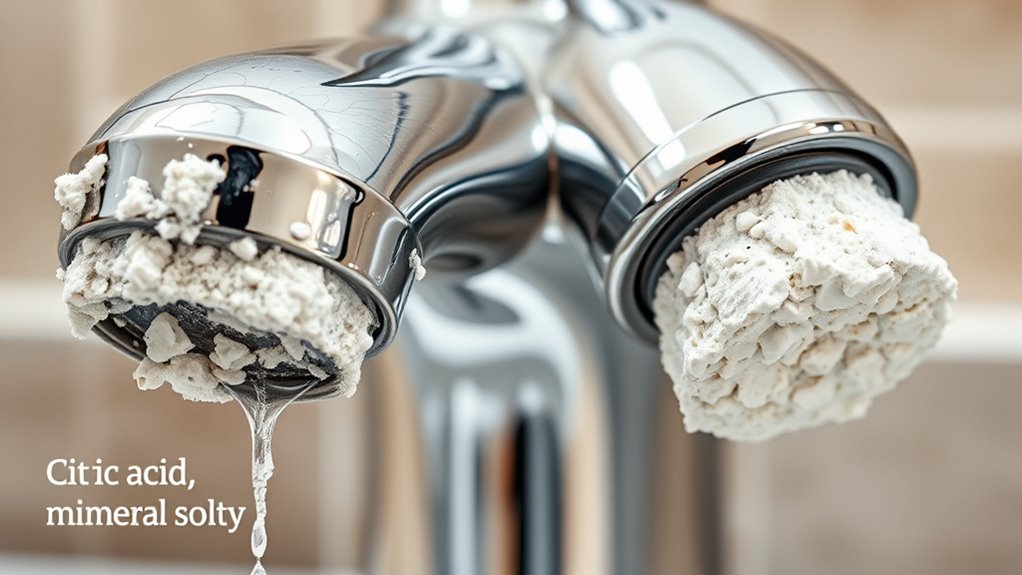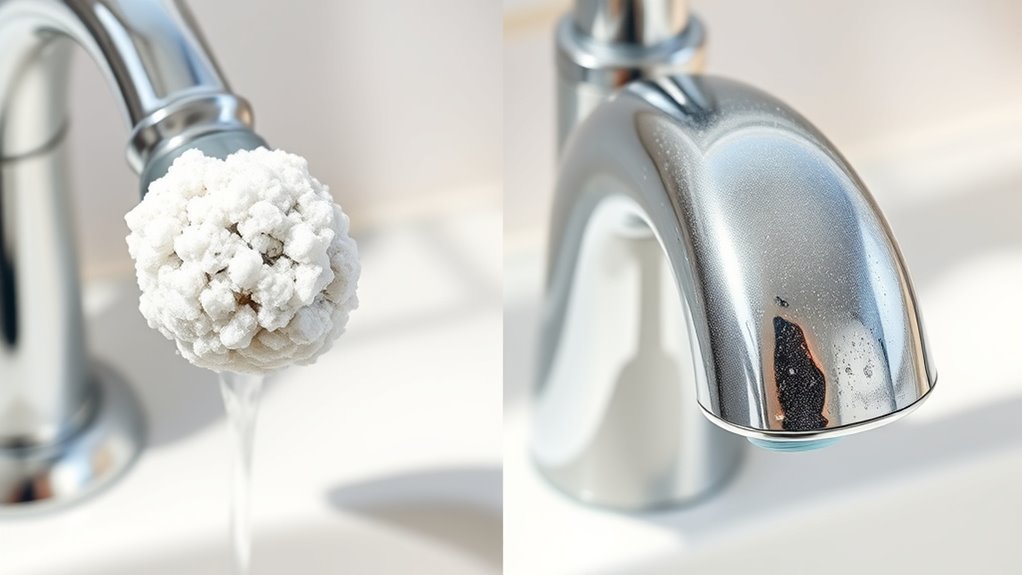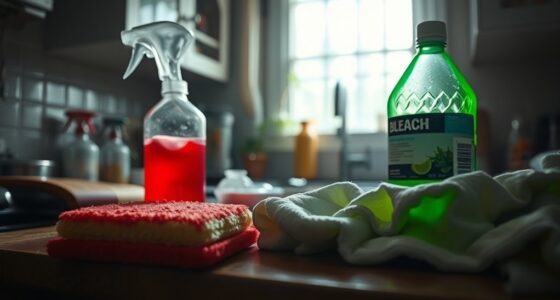When tackling stubborn limescale on faucets, citric acid often outperforms vinegar due to its stronger acidity, breaking down buildup faster. Vinegar is perfect for light to moderate deposits and is eco-friendly, affordable, and easy to use by soaking a cloth. Citric acid, being more potent, works better on tough deposits and dissolves scale quickly. Want to discover the best approach for your faucet? Keep exploring for more expert tips.
Key Takeaways
- Citric acid dissolves limescale faster and is more effective on stubborn deposits than vinegar.
- Vinegar is suitable for light buildup, while citric acid handles severe or persistent limescale.
- Both solutions are eco-friendly, biodegradable, and non-toxic for safe household use.
- Vinegar is more accessible and affordable as a household staple, citric acid offers concentrated power.
- Proper application—soaking or applying directly—maximizes effectiveness for both solutions.

Limescale buildup on faucets is a common problem, especially in areas with hard water. It can make your fixtures look dingy and reduce water flow, which is frustrating. When tackling this issue, many people wonder whether natural remedies like citric acid or household staples like vinegar are more effective. Both options are popular because they’re affordable, eco-friendly cleaning choices, and often preferred over harsh chemicals. However, understanding their differences can help you choose the best solution for your needs, especially if you’re looking for a commercial solution that aligns with eco-conscious practices.
Vinegar is widely known as a household staple for removing limescale. Its acetic acid works by dissolving calcium deposits that form on your faucets. You can easily apply vinegar by soaking a cloth or paper towel in it, wrapping it around the affected area, and leaving it for a few hours or overnight. For more stubborn buildup, a vinegar soak often does the trick without requiring scrubbing. Vinegar is considered an eco-friendly cleaning option because it’s biodegradable, non-toxic, and inexpensive. It’s also readily available in most households, making it a convenient choice for everyday maintenance. If you prefer commercial solutions, many eco-friendly cleaning brands offer vinegar-based sprays or wipes designed specifically for mineral deposits. These products often contain added natural enzymes or surfactants that boost cleaning power without harming the environment.
Citric acid, on the other hand, is a natural organic compound found in citrus fruits. It’s highly effective at breaking down limescale because of its strong acidity. You can buy pure citric acid powder and make a cleaning solution by dissolving it in water. Applying this solution directly to the affected area or soaking fixtures in it can quickly loosen and dissolve stubborn deposits. Citric acid is often favored in eco-friendly cleaning because it’s biodegradable, non-toxic, and leaves no harmful residues. Plus, it tends to be more potent than vinegar, making it a good choice for severe buildup. Commercial solutions containing citric acid are also available, specifically marketed as eco-friendly cleaning options. These products often combine citric acid with other natural ingredients to enhance cleaning efficiency while maintaining an environmentally conscious profile.
When choosing between the two, consider that citric acid’s stronger potency makes it particularly effective for severe buildup, especially in areas with persistent deposits. Both are safe, eco-friendly cleaning options that align with sustainable practices, especially when you opt for commercial solutions designed with environmental consciousness. By understanding the strengths of each, you can effectively remove limescale from your faucets while staying true to eco-friendly principles.
Frequently Asked Questions
Can Citric Acid Damage My Faucet’s Finish?
Citric acid generally won’t damage your faucet’s finish if used properly. You should avoid prolonged contact and excessive cleaning frequency, as frequent or harsh applications might wear down delicate finishes. Always dilute the citric acid and test it on a small area first. Regular, gentle cleaning helps maintain your faucet’s appearance without risking damage to the finishes. Proper use guarantees your faucet stays shiny and protected.
How Long Does Each Solution Take to Remove Limescale?
You’ll see that vinegar typically takes about 30 minutes to an hour to loosen limescale, while citric acid works faster, often within 15 to 30 minutes, depending on its concentration. Your cleaning frequency influences results—regular treatment prevents buildup. Using a more potent solution accelerates the process, but be cautious not to damage the finish. For stubborn deposits, a longer soak with either solution can be more effective.
Are There Eco-Friendly Alternatives to Vinegar and Citric Acid?
Sure, you can ditch vinegar and citric acid for eco-friendly options that won’t make your faucet cry. Biodegradable cleaning products and natural remedies like baking soda, lemon juice, or even rubbing alcohol do the trick, all while saving the planet one limescale at a time. Who knew cleaning could be so green and glamorous? So go ahead, embrace these greener alternatives and let your faucet sparkle without guilt!
Will These Methods Work on All Faucet Types?
These methods work on most faucet types, but your faucet material matters. For example, avoid using vinegar on delicate finishes like brushed nickel or polished chrome, as it may cause damage. Citric acid is gentler but still check your faucet’s cleaning instructions. Regular cleaning frequency helps prevent stubborn limescale buildup. Always test a small area first, and use appropriate concentrations to protect your faucet’s finish while effectively removing limescale.
How Often Should I Clean Limescale From My Faucets?
Imagine you’re in a Victorian-era home, but limescale is your modern foe. You should clean your faucets at least once a month to keep limescale at bay. Regular cleaning frequency is essential for effective preventative maintenance, preventing buildup before it becomes stubborn. If you notice more limescale, increase cleaning intervals. Staying consistent helps maintain your faucet’s shine and function, saving you effort and costly repairs down the line.
Conclusion
In your fight against stubborn limescale, both citric acid and vinegar offer effective options. Whether you choose the powerful punch of citric acid or the vinegar’s versatile victory, you’re in control. Remember, consistent cleaning keeps faucets fresh and free from filmy fouling. So, pick your potent potion, and promptly prevent pesky deposits from piling up again. With these simple solutions, you’ll keep your faucets flawless, fun, and free from future fuss!









